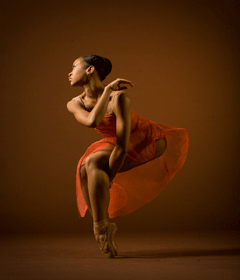
When introducing the world premiere of Refractions on Friday, the choreographer Alonzo King of San Francisco’s Lines Ballet told the audience to treat the dance as food. Even if the food seems strange, King said, taste it anyways. Since he founded his company 27 years ago in San Francisco, King has blended together African dance, ballet and contemporary movement into the ingredients of his choreography. If Refractions, King’s latest work, is food, it is a meal of small plates, some quite delicious, others quotidian, brought course by individual course to the audience. King serves it up with the help of legendary New York jazz pianist Jason Moran, who created an original score for this work that owes much to Charles Mingus.
Capitalizing upon the frisson of traditional ballet and contemporary style, King composes Refractions mostly as a string of little dances: solos and duets, and occasionally duets turned trios, upon the arrival of a third dancer who becomes the principal in the next section. In the opening salvo, David Harvey delivers Caroline Roche literally by the hair, and an off kilter tug of war ensues in which the audience is treated to flexing, torso-thrusting movements that are peppered by Moran’s jazzy effects. In ensuing courses, dancers contort, pirouette and leap romantically, thuddingly, or jauntily, in accompaniment to a range of music, including some drums. When the movement and music are perfectly intertwined, this works wonderfully; when they aren’t, there’s a sense of hollow shapes being made on stage without consideration for musical propulsion. Still, King and his dancers often achieve a seamless momentum through some lovely sequences.
King is among a handful of venerable choreographers who first harnessed other genres to create new and “strange” movement out of the familiarity of the classical western art form of ballet. Likewise, Alvin Ailey Dance Theatre and Philadanco combine ballet, contemporary dance, and African dance to varying degrees, and their popularity has inoculated the audience of the notion that melding these dance forms is exotic. In fact, many contemporary dance companies today regularly fuse ballet, modern and non-western dance, and laboratories for dance such as the American Dance Festival showcase cutting-edge choreographers who interweave dance forms to create new movement that is not just beautiful, but that is truly new and meaningful. In Refractions, King has created some tasty food, but strange it is not.
Lines Ballet will tour various cities in Europe and the Unites States beginning in early 2010.
















